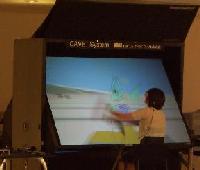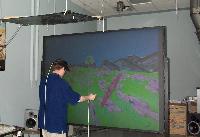
- public access - although the CAVE was a collaboration between artists and scientists, currently there are 3-4 CAVEs in public spaces, open to the public daily, and showing art or cultural heritage content, including:
- problems for museums and in entertainment industry
- high cost of VR systems makes them rare
- economies of through-put make it hard to keep VR experience interactive
- possible ubiquity of useful & fascinating media
- e.g. VR in schools - for several years the Quickworlds project at Abraham Lincoln Elemetary School, Oak Park has integrated an Idesk into its curriculum (project with EVL)
- VR systems in cultural spaces, educational institutions, and entertainment world for purposes of:
- experiencing applications
- experimenting with a new art media
- creating applications in any field that benefit from VR's strengths
- my personal motivation
- art and vr drama projects that I want to be able to show everywhere
- one on one experience with VR
- UB system
- based on IDesk in terms of tracking system, and screen size
- Two major developments promised to bring down costs
- Passive rather than active stereo
- 2 projectors with polarizing filters
- screen that does not depolarize light
- cheap plastic/cardboard glasses
- by late Spring of 2000, Greg Dawe at the Electronic Visualization Laboratory, University of Illinois at Chicago, had researched screen materials, filters and projectors, and done a series of experiments to prove this could be done
- Using a PC
- video games industry pressure -> produce fast video cards
- development of dual headed video cards - so one machine could put out 2 channels of video, one for the left and one for the right eye
